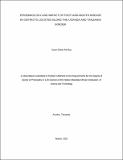| dc.contributor.author | Kerfua, Susan Diana | |
| dc.date.accessioned | 2020-09-22T07:08:28Z | |
| dc.date.available | 2020-09-22T07:08:28Z | |
| dc.date.issued | 2020-03 | |
| dc.identifier.uri | https://dspace.nm-aist.ac.tz/handle/20.500.12479/926 | |
| dc.description | A Dissertation Submitted in Partial Fulfilment of the Requirements for the Degree of
Doctor of Philosophy in Life Sciences of the Nelson Mandela African Institution of
Science and Technology | en_US |
| dc.description.abstract | The Uganda-Tanzania border area lies within the main risk areas for foot-and-mouth disease
(FMD) circulation. With the introduction of the progressive control pathway for FMD in
eastern Africa, reliable information on FMD epidemiology along the Uganda-Tanzania
border area is important in informing the pathway such that, strategic collaborative controls
are designed. The scarcity of information on FMD impact in both Uganda and Tanzania,
leaves a gap in information critical for justification for national and regional expenditures for
FMD intervention. The objectives of the present study were to; (i) determine the spatial and
temporal distribution of FMD in districts along the Uganda–Tanzania border between 2011
and 2016 (ii) determine genetic relationships between FMD viruses circulating between 2016
and 2017 and, (iii) ascertain the impact of FMD on income and food security. The study was
carried out in the border districts of Missenyi and Kyerwa in Tanzania and Rakai and Isingiro
in Uganda. For objective (i), retrospective data was compiled and analysed in R and maps
were drawn using QGIS. Results showed that 46% of the 82 recorded outbreaks occurred in
sub-counties/wards immediately neighbouring the Uganda-Tanzania border and 69.5% of the
outbreaks occurred during dry months. For objective (ii), 43 samples were analysed using
PCR and 11 were successfully sequenced. Sequences were analysed and trees drawn using
MEGA 7. Phylogenetic analysis of the VP1 coding region showed that serotype O viruses
obtained belonged to EA-2 topotype and clustered together with an average sequence
divergence of 4.9%. Obtained serotype A viruses belonged to Africa-G1 topotype, formed
one cluster with a 7.4% sequence divergence. For objective (iii) data was collected from 288
households using a structured questionnaire. Results showed significant reduction in income
from livestock and livestock products sales by over 60%, whereas livestock market prices
decreased by nearly half. Forty nine percent of farmers reported calf mortalities and milk
consumption in households reduced by 57% in Rakai and Isingiro and 48% in Missenyi.
These findings provide information helpful for policy reform, and designing better strategies
for FMD control. The study recommends comprehensive regional studies to be implemented
in border areas. | en_US |
| dc.language.iso | en | en_US |
| dc.rights | Attribution-NonCommercial-ShareAlike 4.0 International | * |
| dc.rights.uri | http://creativecommons.org/licenses/by-nc-sa/4.0/ | * |
| dc.subject | Research Subject Categories::NATURAL SCIENCES | en_US |
| dc.title | Epidemiology and impact of foot-and-mouth disease in districts located along the Uganda and Tanzania border | en_US |
| dc.type | Thesis | en_US |


